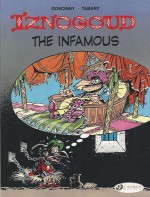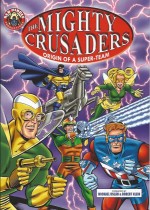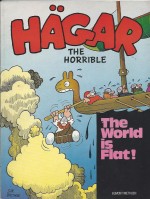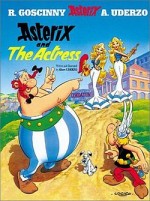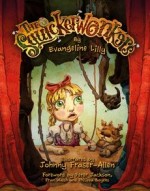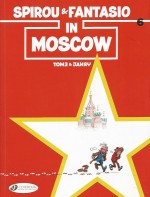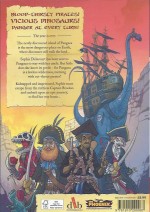

By Daniel Hartwell & Neill Cameron (David Fickling Books)
ISBN: 978-1-910200-08-7
Why are pirates so mean? I don’t know, they just AARRRR…
In January 2012 Oxford-based family publisher David Fickling Books launched a traditional anthology comics weekly aimed at girls and boys between 6 and 12 which revelled in reviving the good old days of picture-story entertainment intent whilst embracing the full force of modernity in style and content.
Each issue still offers humour, adventure, quizzes, puzzles and educational material in a joyous parade of cartoon fun and fantasy. In the years since its premiere, The Phoenix has gone from strength to strength, winning praise from the Great and the Good, child literacy experts and the only people who really count – the astoundingly engaged kids and parents who read it…
The Phoenix was voted No.2 in Time Magazine‘s global list of Top Comics and Graphic Novels and is the only strip publication started in the UK in the last forty years to have passed the 100 issue mark. It celebrated its first anniversary by developing a digital edition available globally as an app and is continually expanding its horizons.
It is, most importantly, tremendous fun, offering not just comedic comic capers, but games, puzzles, “How-To…†pages and even adventure strips.
Crafted by Daniel Hartwell (Urban Beasts) and Neill Cameron (Mo-Bot High, How to Make Awesome Comics), by far the most engaging thriller so far featured is a sublime combination of classic endeavour and enticing fantasy which blends bold buccaneers, boldly brilliant kids, suspenseful swashbuckling escapades and gloriously gigantic dinosaurs.
The alternate-history lesson begins with twelve year old Sophie Delacourt voyaging out from England in 1717 to join her Uncle Silas, the newly appointed Governor of the lost land of Pangaea.
The huge island-continent is reputed to be the oldest land on Earth and a place primarily inhabited by colossal reptiles of the land and air. Master Bosun William takes a paternal interest in the girl, explaining the wondrous nature of the place, but nothing prepares Sophie for the experience of a colossal “long-neck†which dives under their vessel and lifts it bodily into the air.
The interior of Pangaea is a vast shifting ocean of long grass afflicted and infested with fast and deadly predators no man afoot could survive or escape, so all ships are picked up out of blue Caribbean waters then carried upon brobdingnagian beasts’ backs between the rocky high points and plateaux where humanity has built its dwellings and settlements.
The big beasts are kept docile and compliant by the administration of a herb dubbed “Snuff†and piloted by the skilful class of inland mariners known as “Snuffmenâ€â€¦
Sophie has never seen anything so wonderful in her life but, as Snuffman John guides the magnificent Bessie and her formerly-seagoing burden towards the Governor’s capital city, the amazed girl catches sight of the ever-present peril which besets this latest outpost of empire.
Through the shifting verdure comes a pirate ship strapped atop a terrifying black Land Leviathan and soon the voyagers are fighting for their lives in an ‘Ambush on Pangaea’.
Sophie is locked in her cabin as the corsairs’ devastating attack pillages the vessel and, when the insanely cruel Captain Brookes cries victory, making the crew walk the plank to their deaths, she is the only survivor…
The second chapter opens with the Governor’s niece imprisoned on Brookes’ land-ship, a potential goldmine in ransom for the greedy maniac. Furious and defiant Sophie is slowly befriended by brute’s cabin boy Timothy Kelsey. The lad is the tormented last survivor of a previous foray which saw the murder of his mentor and master Dr. Shaw; a naturalist who had come to the lost land to catalogue the ‘Indigenous Fauna of the Pangaean Land-Mass’.
After witnessing Brookes’ cruelty, Sophie agrees to join in the boy’s desperate plan for escape but as they make their move to fly off on the ship’s captive “Great Wing†lizard, they stumble over the Captain’s first mate.
Ten Gun Jones is also engaged in fleeing on the “Razor Beakâ€, but the noise of their stumbling over each other rouses the ship and the three are forced to flee together into the night amidst a hail of musket fire…
Soon the trio are hopelessly ‘Lost in the Sea of Green’ as their gravely wounded pterosaur expires just short of a high-projecting stony pinnacle. With deadly “Land Sharks†and “Belly Rippers†closing in on them all hope seems lost until an even deadlier beast pounces.
The “Tyrant†makes short work of the circling velociraptors, but its ravening hunger remains unsated. Only sheer terror carries the three fugitives to the relative safety of the rocky islet and, frantically scaling the igneous tower with the horror snapping at their heels, they all tumble into a cave to find themselves inside an abandoned pirate den…
The dusty lair has weapons, lamps, water, liquor and even brontosaur jerky; everything they might need to outwait the roaring giant outside, but after a sleepless night with Ten Gun less than forthcoming about why he was deserting Captain Brookes, Sophie conceives a dangerous idea.
After feeding the monster chunks of the dried meat liberally doused in the Snuff she found in a barrel, in an act of seeming madness Sophie drops onto the horror’s head and soon has it – or rather her – acting like a very dangerous steed…
The fearless lass then explains how an elderly servant in England taught her the secrets of horse-whispering before christening her scaly new pet “Cornflowerâ€. Timothy is elated that they can use the Tyrant to safely cross the lethal Sea of Green to civilisation but Jones has other plans…
The enigmatic pirate’s guarded directions soon bring them to an active volcano which is in truth the neutral port used as a safe-haven by all the freebooters plying the grassy deeps. In a tavern the children learn the ‘Secrets of Raptor Rock’ and are introduced to bombastic Captain Ford, who previously planted Ten Gun in Brookes’ crew to secretly secure the second half of a disputed treasure map…
With both pieces secure the privateer immediately sets to emerald sea, but Ten Gun insists on bringing Sophie and Tim along. They have barely left the rock before Cornflower breaks out of her pen and doggedly follows…
The children are put to work and Sophie soon makes friends with Iwakian Snuffman Tak: a native Pangaean who steers the buccaneers’ bombastic brontosaur Gertrude…
The exploratory voyage comes to a sudden end after crossing the eerie “Longnecks Graveyard†when they hove into view of the fantastic plateau known in legend as “The Forbidden Isleâ€â€¦
An expeditionary party is soon driving inland to a ancient temple in ‘Quest for the Golden Skull’ but upon entering, the greedy pirates are astounded to discover that the invaluable artefact they’re hunting is not a gilded human head but actually a full size tyrant’s skull cast in precious metal…
That’s when ferocious native defenders – the Kron Iwakia – ambush the party, driving them back to the relative safety of Gertrude, but the rapidly retreating raiders have no idea of what’s happened in the meantime.
Young Kelsey, resentful of being enslaved again has – more by accident than design – blown up the ship and stampeded Gertrude off into the Sea of Green just as maniacal Captain Brookes arrives intent on reclaiming his map and slaughtering everyone…
Even though the enraged Iwakians vanished when the ship began to burn, Ford’s rattled crew are no match for the nautical newcomers and things look bleak and bloody. Sophie and Kelsey desperately head back to the temple chased by Brookes’ men and death seems imminent until, from nowhere, Cornflower hurtles into action and eagerly despatches the pursuing pirates.
This prompts the Kron Iwakia to emerge from concealment to guide Cornflower and the kids back to the temple. The natives worship Tyrant lizards and after a strange ceremony deem Sophie and her reptile holy. That’s when Tim realises that the Golden Skull is not a mere ornament but battle armour for a tyrannosaur Chosen One…
With the Iwakians in close support the valiant children return to the ongoing pirate war to settle a number of old scores before taking control of their own destinies…
Superbly engaging and utterly enthralling, this astounding all-action romp is a riotous delight of astonishing adventure and this fabulous first compilation also includes many maps and crucial fact pages on the assorted dinosaurs from Dr. Shaw’s ‘Indigenous Fauna of the Pangaean Land-Mass’ – specifically ‘Sauropoda’, ‘Pterosauria’, ‘Dromaeosauridae’ and ‘Tyrannosauridae’ – all scrupulously crafted, corrected and annotated by erstwhile cabin boy and greatest living expert Timothy Kelsey…
Bright, breezy furious fun for the entire family, so don’t miss this unburied treasure…
Text © Daniel Hartwell 2015. Illustrations © Neill Cameron 2015. All rights reserved.


